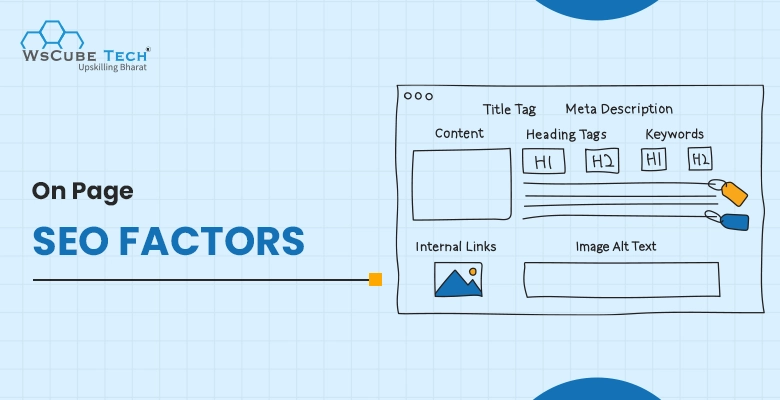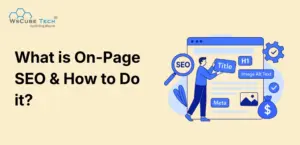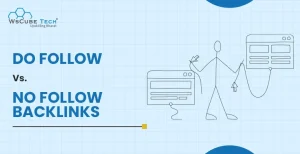To rank your website higher on search engines and attract more visitors, on-page SEO is where you should begin. It’s one of the most crucial aspects of digital marketing and SEO, as it determines how search engines understand your website content.
In this blog, we’ll break down what on-page SEO is, why it matters, and the most efficient on-page SEO factors in 2025 to help your web pages stand out.
What is On-Page SEO?
On-page SEO, also known as on-site SEO, is the process of optimizing each web page so they rank higher in search results and bring in more relevant traffic. It’s all about improving the content and structure of pages for users and search engines.
Some common on-page SEO practices include:
- Optimizing titles and headings
- Using keywords naturally in your content
- Improving page speed
- Writing engaging meta descriptions
- Adding internal links to other website pages
- Making sure your site is mobile-friendly
On-page SEO involves making a website’s content easier to read, understand, and navigate for both people and search engines.
How is it different from off-page SEO?
Off-page SEO refers to activities that happen outside your website, such as getting backlinks, social media promotion, influencer mentions, and guest blogging. On the other hand, on-page SEO happens on your site and gives search engines clues about what your page is all about.
Also read: Top 10 AI SEO Tools to Use in 2025
Why Do On-Page SEO Factors Matter?
On-page SEO helps search engines understand what your content is about and whether it’s relevant to a user's query.
When you optimize your pages properly:
- Search engines index your pages more accurately
- Your site becomes more discoverable to your target audience
- You attract more qualified visitors
- You increase the chances of engagement, sign-ups, or sales
Great content isn’t enough. You need to make sure it’s structured in a way that search engines can easily crawl and understand, and that is where we have impactful on-page SEO factors.

Top On-Page SEO Factors
Here are the key on-page SEO factors you should consider:
- Meta title tags
- Heading tags
- Meta descriptions
- E-E-A-T factors
- Relevant keywords
- Page URL
- Unique Content
- Site architecture
- Page Loading speed
- Mobile-friendliness
- Image Optimization
- User Experience (UX)
- Contact and Business Information
- Google Business Profiles
- Business Directory Listings
- Internal links with anchor text
1. Meta title tags
The title tag and meta description are often the first things users see in search results. Hence, they need to be:
- Clear and engaging
- Include your main keyword
- Within character limits (60 for title, 160 for description)
- Encourage people to click on your link
Tip: Make your title enticing by adding numbers or power words like “Best,” “Ultimate,” or “Guide.”
2. Heading tags
Header tags help break your content into readable sections, making it easier for search engines to understand its structure.
- Use one H1 tag per page (usually the title)
- Use H2s and H3 headings to organize subtopics
- Include keywords in some headers when it makes sense
This not only helps with SEO but also improves user experience, especially for readers skimming through your content.
3. E-E-A-T factors
Google values content that comes from real people with real experience. E-E-A-T helps Google judge the credibility of your content.
Experience: Has the author personally used or done what they’re writing about?
Expertise: Does the author have knowledge or qualifications in the topic?
Authoritativeness: Is the website recognized as a go-to source?
Trustworthiness: Is the site secure, transparent, and reliable?
Tip: Add author bios, show credentials, cite sources, and include real-world examples to build trust.
4. Relevant keywords
Keywords are still important, but the way we use them has evolved. It’s no longer about stuffing keywords into your page. Keywords are crucial on-page SEO ranking factors that require you to focus on:
- Using targeted keywords naturally in your content, headings, and subheadings
- Including related terms and LSI (Latent Semantic Indexing) keywords
- Matching search intent and understanding why someone is searching for a term
Example: If you're targeting “healthy smoothie recipes,” you should also include related terms like “vegan smoothies,” “fruit-based drinks,” or “low-calorie smoothie ideas.”
5. Page URL
Clean, simple URLs are easier for both users and search engines to understand.
A good URL:
- Is short and descriptive
- Uses keywords
- Avoids numbers and unnecessary characters
Example:
www.yoursite.com/seo-tips- correct URL
www.yoursite.com/page-id=1234- wrong URL
6. Unique Content
In 2025, Google is prioritizing useful and original content that answers user queries clearly.
To improve your content:
- Write for your audience and not just for SEO
- Avoid fluff and keyword stuffing
- Include examples, tips, stats, and visuals when possible
- Regularly update your content to keep it relevant
Example: Instead of writing a generic article on “home workouts,” create a detailed guide with beginner tips, routines, video tutorials, and common mistakes.
7. Site architecture
How your website is structured plays a big role in SEO. A clear, organized site makes it easier for both users and search engines to navigate and understand your content.
Best practices include:
- Using a clean URL structure
- Creating a logical page hierarchy
- Linking between pages internally
- Having an easy-to-use navigation menu
Example: A blog with categories like “SEO Tips,” “Content Marketing,” and “Analytics” makes it easier for readers to explore related topics—and helps Google crawl your site better.
Also read: SEO KPIs: Top 14 KPIs for SEO to Track & Measure

8. Page Loading Speed
Speed is also among the most important on-page SEO factors. It plays a huge part in user experience. If your site takes too long to load, visitors will bounce, and Google notices that.
To improve speed:
- Compress images
- Use caching plugins
- Minimize JavaScript and CSS files
- Choose a fast, reliable hosting provider
Tip: Run your site through PageSpeed Insights or GTmetrix to identify speed issues.
9. Mobile-friendliness
With most searches happening on mobile phones, Google uses mobile-first indexing, which means it primarily looks at your site’s mobile version when ranking pages.
To optimize for mobile:
- Use a responsive design
- Ensure buttons and text are easy to tap and read
- Avoid heavy pop-ups that cover content
Tool to try: Use Google’s Mobile-Friendly Test to check your site.
Essential SEO Topics You Should Know
| Types of SEO | SEO Syllabus | SEO KPIs |
| Types of Backlinks | SEO Tools | Search Engine Functions |
| Keywords Types in SEO | Local SEO Ranking Factors | Website Speed Test Tools |
10. Image Optimization
Images make your content more engaging, but they also need to be optimized.
How to do it:
- Use descriptive file names (e.g., "on-page-seo-guide.jpg")
- Add alt text for accessibility and SEO
- Compress images to reduce load time
- Use relevant visuals to support your content
11. User Experience (UX)
Google wants to rank pages that provide a good experience. That means your site should be:
- Easy to navigate
- Visually appealing
- Free from annoying pop-ups
- Clear in layout, especially on mobile
Watch out for: High bounce rates and low dwell time, as these can signal that users aren’t finding what they expected.
12. Contact and Business Information
Your website should display your contact information, including your business address, phone number, and email address. This builds trust with visitors and shows Google that you're a legitimate business.
- Include a dedicated Contact Us page
- Add consistent business info in the footer
- Use the same name, address, and phone number (NAP) everywhere
This information also supports your local SEO efforts, especially for service-based or location-specific businesses.
13. Google Business Profiles
Having a well-optimized Google Business Profile (formerly Google My Business) helps boost your visibility in local search and Google Maps.
Make sure to:
- Add accurate business info
- Upload photos
- Collect customer reviews
- Update hours and services regularly
Example: If someone searches for “plumber near me,” Google often shows local business profiles before regular website links, so keeping your profile active can bring you to the top.
Also read: How to Become an SEO Expert? (Beginner’s Blueprint 2025)
14. Business Directory Listings
Listing your business on reputable directories like Justdial, Sulekha, IndiaMART, or Yelp can help improve your online presence and credibility.
Ensure your information is:
- Consistent across all platforms
- Linked back to your website
- Updated with the latest details and offerings
These listings can also generate referral traffic and strengthen your local SEO through citations and backlinks.
15. Internal links with anchor text
Internal links are used to connect one page of a website to another. This helps:
- Users discover more content
- Search engines crawl your site better
- Pass SEO authority across pages
Tip: Link to older blog posts or product pages using descriptive anchor text. For instance, link to your “SEO Tools for Beginners” article from your blog on “SEO Best Practices.”

FAQs About On-Page SEO Factors
On-page SEO factors directly influence how well your content ranks on search engines. In 2025, with Google’s algorithms becoming more advanced, elements like content quality, page speed, mobile-friendliness, and E-E-A-T play an even bigger role in helping your page stand out.
E-E-A-T (Experience, Expertise, Authoritativeness, Trustworthiness) helps search engines assess the credibility of your content. By showing that your content is written by someone knowledgeable and trustworthy, you boost your chances of ranking higher.
Internal linking helps connect related pages on your website. This not only improves user navigation but also enables search engines to understand the website structure and content relevance.
Google uses mobile-first indexing, so it primarily considers the mobile version of any website for search engine ranking. A mobile-optimized website provides an enhanced user experience, which is a major on-page ranking factor.
Use clear and concise title tags with your main keyword, and write compelling meta descriptions that summarize the content and encourage clicks. Meta tags don’t directly impact rankings, but they can improve your click-through rate, which does.
Conclusion
On-page SEO in 2025 is more than just adding keywords; it’s about creating a well-rounded, user-friendly, and trustworthy experience for both search engines and visitors. From optimizing web content and meta tags to ensuring mobile responsiveness, fast loading speeds, and building credibility through E-E-A-T, each on-page SEO factor contributes to your site's visibility and performance.
By focusing on the right on-page elements, you not only improve your rankings but also enhance your visitors' experience, leading to better engagement, lower bounce rates, and higher conversions.
Keep your site updated, user-centric, and technically sound. Because in today’s competitive digital world, strong on-page SEO is the foundation of lasting online success.
Explore Our Free Courses




Leave a comment
Your email address will not be published. Required fields are marked *Comments (0)